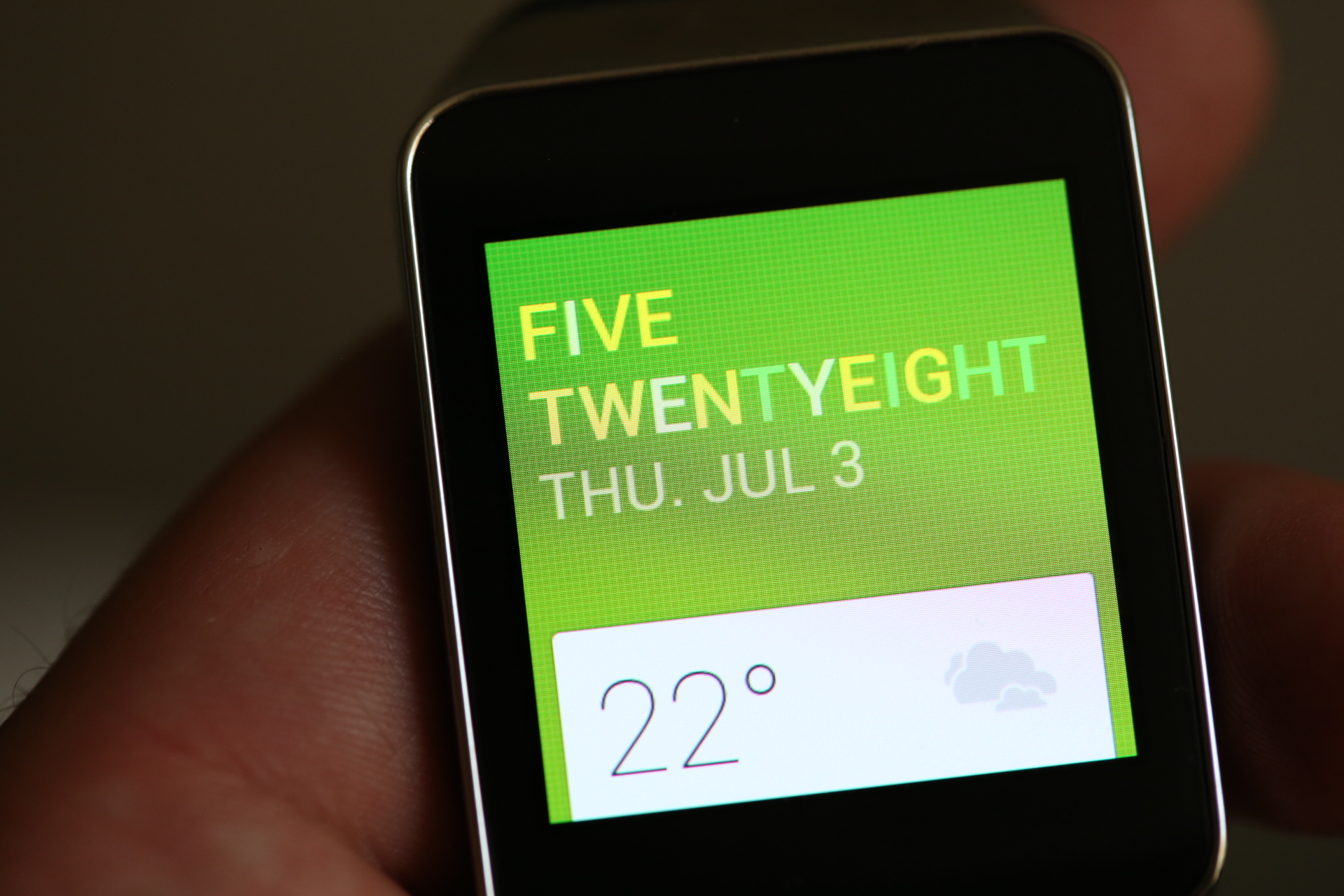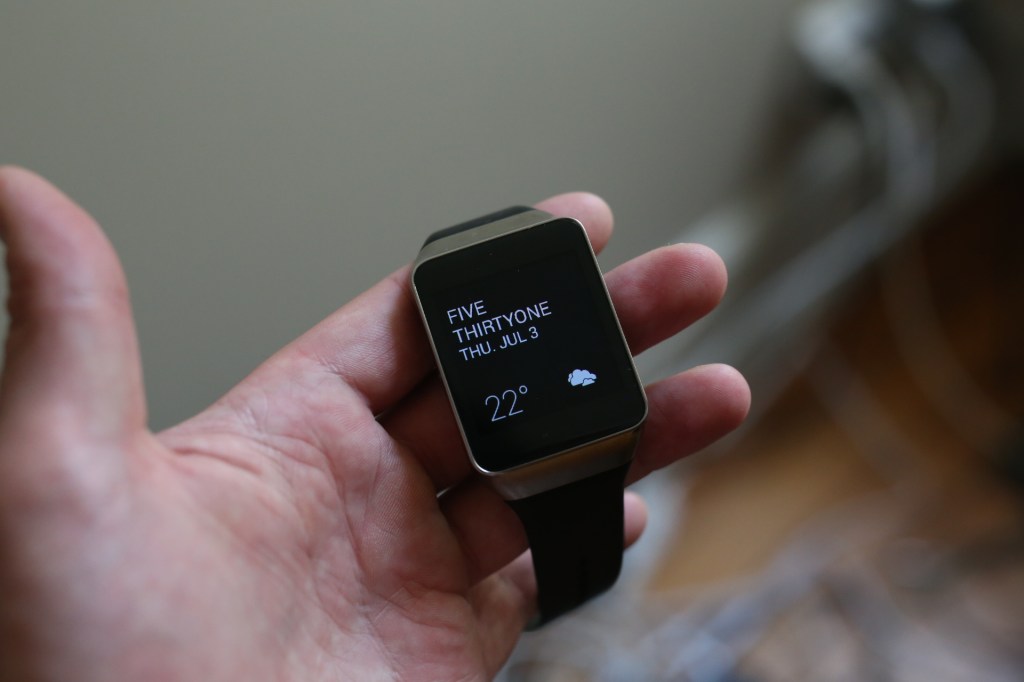Samsung is one of the first to market with an Android Wear smartwatch, and the company arguably has a head start since it’s been making its own smartwatches since last year. The Gear Live owes much to its predecessors, which have run both a modified version of Android and Samsung’s own Tizen, but it manages to feel like much more than an older sibling’s hand-me-downs.
Video Review
Basics
- 1.63-inch Super AMOLED 320×320 display
- 1.2GHz Processor
- 512MB RAM with 4GB storage
- Comes in black and wine red
- MSRP: $199
- Product info page
Pros
- Great screen
- Heart rate monitor
Cons
- Battery life
- Polarizing design
Design
Samsung hasn’t strained themselves with the Gear Live’s design – this is a very similar device to the Gear 2 on the outside, minus the camera at the top and the button at the bottom. It looks a lot like an original Galaxy Gear, in fact, but with a bezel that makes the screen seem a bit more like it’s protruding from your wrist and cleaner lines overall. The minor tweaks are for the better, however, and this is overall a better-looking device than any of Samsung’s older smartwatches.
The design is much more prone to strong negative reactions than that of the LG G watch, however, at least in my experience. While many were fine with its looks, a lot more said they definitely didn’t like it, vs. a mostly neutral or net positive reaction to the G Watch. You’re less able to add your own personal flair to the Gear Live, too – it uses a proprietary band connector meaning aftermarket options aren’t nearly as readily available.
That said, the wrist-hugging design is comfortable on the wrist, and though the clasp isn’t all that easy to affix to begin with, it’s secure once you’ve got it clipped in. Samsung also gets points for including a recessed hardware button on the right side of the display – it’s every bit as surreptitious as LG’s complete lack of any physical controls, but loads more convenient for power on/power down functions.
Software
As mentioned in my review of the LG G Watch, all Android Wear devices are virtually identical in terms of their software experience so far, and that’s by design. The exception here is that Samsung offers some of its own apps for monitoring heart rate and activity (alongside the native Google-provided software for handling both).
The similarity of experience is a very good thing: users who learn Android Wear once will never have to go through a learning curve or adjustment period again when they upgrade or change devices, so long as Google sticks with this plan.
Android Wear does offer everything that users should need in a smartwatch, however, and nothing more. The crucial part will be keeping things clutter free: I enjoyed the relatively spare influx of notifications and activity possible on the wrist, but developers will be able to do a lot more with the Wear SDK, so simplicity might not last forever.
Existing watch apps from partners including Pinterest offer interesting functionality, however. And Google’s own turn-by-turn navigation on the wrist is pretty much perfect for walking or even biking (if you’re extra careful) places without continually taking your phone out of your pocket.
Display

Samsung has proven with its most recent devices that if there’s one place it excels, it’s in display tech. The Super AMOLED screen on the Gear Live has all of the advantages of the big, bombastic versions it includes in its new Tab S line of Android tablets, but shrunk down and on your wrist.
Those advantages include super contrast and deep blacks thanks to the absence of a backlight, decent daylight visibility and colors that really pop. Receiving photos on the Gear Live through Hangouts actually provided a pleasant enough experience that I was seldom tempted to reach into the pocket and pull out the connected phone, in fact.
Samsung’s screen is also more pixel-dense than LG’s, and it makes a difference. Text appears super crisp and legible, and overall Samsung is the clear winner when it comes to display quality.
Battery
The battery on the Gear Live is one of its least appealing features. Your watch will probably last you through any given day, but don’t expect it to go much further than that. Depending on how actively you’re using the device, you’ll probably need to hit the charger around the same time your head hits the pillow.
The price of wearables, at least for now, appears to be getting used to the fact that these devices require at least as much charging as our smartphones. Samsung’s charger is at least small and easy to hide on a nightstand, but it clips in with a ferocity that makes plugging in and unplugging
Bottom Line
Samsung may not have had to do much to pivot its own existing smartwatch efforts into a launch day product for Android Wear, but that doesn’t mean the device it did ship feels half-baked. In fact, if anything it benefits from not having been as rushed as its competition, and for the time being at least, that earns Samsung bragging rights as the best available Android Wear device for most users.




































Comment